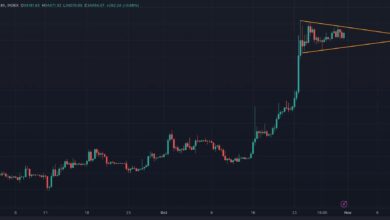
Bitcoin Price After 10 Years Expert Predictions & Analysis 2025 2035 Crypto Forecast
The bitcoin price after 10 years remains one of the most debated topics in cryptocurrency investment circles. As we navigate through 2025, Bitcoin has already demonstrated remarkable resilience and growth potential, with current predictions suggesting extraordinary price movements over the next decade.
Understanding where Bitcoin might trade by 2035 requires analyzing multiple factors, including market adoption, regulatory developments, technological advances, and macroeconomic conditions. This comprehensive analysis explores expert predictions, historical patterns, and fundamental drivers that could shape the bitcoin price after 10 years, providing investors with crucial insights for long-term planning.
Current Bitcoin Market Overview in 2025
Bitcoin has established itself as a mature digital asset class in 2025, with institutional adoption reaching unprecedented levels. The cryptocurrency currently trades with significantly reduced volatility compared to previous cycles, reflecting increased market maturity and broader acceptance among traditional financial institutions.
Key developments in 2025 include the continued success of Bitcoin ETFs, which have attracted billions in institutional capital. The approval and widespread adoption of spot Bitcoin ETFs have fundamentally changed how traditional investors access Bitcoin exposure, creating sustained demand pressure that supports higher price levels.
Mining operations have also evolved significantly, with increasing focus on renewable energy sources and improved efficiency. The Bitcoin network’s hash rate continues to reach new all-time highs, indicating robust network security and miner confidence in long-term profitability.
Bitcoin Price After 10 Years: Expert Predictions
Conservative Estimates for 2035
Conservative analysts project Bitcoin reaching between $200,00o $500,000 by 2035. These predictions assume steady but moderate adoption growth, regular regulatory clarity, and continued technological improvements. Finder.com reports that Bitcoin is predicted to reach $145,167 by 2025, $458,647 by 2030, and over $1 million by 2035.
The conservative view accounts for potential market corrections, regulatory challenges, and competition from other digital assets. These projections often use traditional valuation models adapted for cryptocurrency markets, focusing on metrics like stock-to-flow ratios and adoption curves.
Moderate Growth Scenarios
Moderate projections suggest Bitcoin could reach $700,000 to $1.2 million within the next decade. These forecasts assume continued institutional adoption, favorable regulatory environments in major markets, and successful implementation of Bitcoin layer-2 solutions for improved scalability.
This scenario incorporates expectations of Bitcoin becoming a standard treasury asset for corporations and potentially central bank reserves. The moderate case also assumes successful navigation of environmental concerns through increased renewable energy adoption in mining operations.
Bullish Long-term Forecasts
The most optimistic predictions for the bitcoin price after 10 years reach as high as $1.5 million to $3 million per Bitcoin. In ARK’s Big Ideas 2025 report, we updated our bitcoin price targets for 2030, projecting bear, base, and bull cases of $300,000,$710,000, and ~$1.5 million per bitcoin, respectively.
These bullish scenarios assume Bitcoin achieves significant market penetration as a global reserve asset, widespread adoption for international trade settlements, and successful resolution of current scalability challenges. The projections also factor in potential monetary debasement in major fiat currencies and Bitcoin’s role as a hedge against inflation.
Factors Influencing Bitcoin’s 10-Year Price Trajectory

Institutional Adoption and ETF Growth
The continued expansion of Bitcoin ETFs represents one of the strongest catalysts for long-term price appreciation. Institutional demand through these regulated investment vehicles provides steady buying pressure and reduces available supply for retail markets.
Corporate treasury adoption continues to accelerate, with more companies following the path established by early adopters like MicroStrategy and Tesla. As corporate Bitcoin holdings become more common, the practice may become standard among cash-rich companies seeking inflation hedges.
Sovereign wealth funds and central banks are increasingly considering Bitcoin allocations, though most remain in exploratory phases. Successful implementation by major institutional players could trigger widespread adoption across the financial industry.
Regulatory Environment and Legal Clarity
Regulatory clarity remains crucial for Bitcoin’s long-term price trajectory. Favorable regulations in major markets like the United States, the European Union, and the Asia-Pacific region could unlock significant institutional capital currently waiting on the sidelines. The development of comprehensive regulatory frameworks provides certainty for institutional investors and enables the creation of more sophisticated Bitcoin financial products.
Clear regulations also reduce counterparty risks and improve market confidence. Cross-border regulatory cooperation on cryptocurrency standards could eliminate current friction in international Bitcoin transactions, potentially increasing utility and demand.
Technological Developments and Scalability
Bitcoin’s Lightning Network and other layer-2 solutions continue developing, addressing scalability concerns that have historically limited Bitcoin’s utility for small transactions. Improved scalability could unlock new use cases and increase adoption across various sectors. T
he ongoing development of Bitcoin smart contract capabilities through proposals like Taproot and potential future upgrades may expand Bitcoin’s functionality beyond simple value transfer, potentially increasing demand from developers and enterprises. Mining technology advances continue to improve energy efficiency and reduce environmental impact concerns. These developments address one of the primary criticisms of Bitcoin and support long-term sustainability.
Historical Patterns and Market Cycles
Understanding Bitcoin’s Halving Cycles
Bitcoin’s four-year halving cycles have historically driven major price movements, with each cycle producing new all-time highs followed by significant corrections. The pattern suggests that supply reductions every four years create scarcity-driven price appreciation. Previous halvings in 2012, 2016, and 2020 each preceded major bull markets, though the magnitude of price increases has gradually diminished as the market matured.
The 2024 halving appears to be following similar patterns with more institutional participation moderating volatility. Future halvings in 2028 and 2032 will further reduce Bitcoin’s inflation rate, potentially supporting higher prices as supply growth continues slowing toward Bitcoin’s maximum of 21 million coins.
Market Maturation and Volatility Reduction
Bitcoin’s volatility has generally decreased over time as market capitalization has increased and institutional participation has grown. This trend toward reduced volatility makes Bitcoin more attractive for institutional treasury management and everyday use cases.
The development of sophisticated derivatives markets provides better price discovery and hedging mechanisms, contributing to more stable price action compared to Bitcoin’s early years. Increased market depth from institutional participation means large trades have less price impact, reducing the extreme price swings that characterized earlier market cycles.
Risk Factors and Challenges
Regulatory and Political Risks
Government actions remain the primary risk factor for Bitcoin’s long-term price trajectory. Potential bans or severe restrictions in major markets could significantly impact demand and prices. Political changes in key jurisdictions could alter the regulatory landscape, creating uncertainty and potentially reducing institutional interest.
The cryptocurrency industry continues working to build positive relationships with regulators worldwide. International coordination on cryptocurrency taxation and reporting requirements could create compliance burdens that affect adoption rates and market growth.
Technological and Security Concerns
While Bitcoin’s network has operated securely for over 15 years, potential technological vulnerabilities or quantum computing threats could pose long-term risks. The Bitcoin development community actively addresses these concerns through ongoing research and development.
Scalability limitations could prevent Bitcoin from achieving broader adoption if layer-2 solutions fail to provide adequate transaction throughput and cost efficiency. Environmental concerns about Bitcoin mining energy consumption continue generating negative publicity, though increasing renewable energy adoption may mitigate these issues over time.
Market Competition and Alternative Assets
Competition from other cryptocurrencies and central bank digital currencies (CBDCs) could limit Bitcoin’s market share and growth potential. However, Bitcoin’s first-mover advantage and network effects provide significant competitive moats.
Traditional asset classes developing digital equivalents might compete for the same institutional capital currently flowing into Bitcoin. The success of tokenized assets and other blockchain-based investment products could affect Bitcoin demand.
Economic and Macroeconomic Factors
Global economic conditions significantly influence Bitcoin’s price trajectory. Periods of economic uncertainty tend to benefit Bitcoin as investors seek alternative stores of value, while strong traditional markets might reduce cryptocurrency demand.
Central bank monetary policies, particularly in major economies, affect Bitcoin’s attractiveness as an inflation hedge. Prolonged low interest rates and quantitative easing programs generally support Bitcoin prices. Currency debasement and geopolitical tensions often drive demand for Bitcoin as a neutral, borderless asset. However, economic stability and strong traditional currencies could reduce this demand driver.
Investment Strategies for Long-term Bitcoin Holdings

Dollar-Cost Averaging Approach
Long-term investors frequently employ dollar-cost averaging strategies to build Bitcoin positions over time, reducing the impact of price volatility and timing risks. This approach particularly suits investors planning to hold Bitcoin for the full 10-year period.
Regular purchases, regardless of price movement, help smooth out market volatility and remove emotional decision-making from the investment process. Historical analysis suggests dollar-cost averaging has been effective for Bitcoin investors with multi-year holding periods.
Portfolio Allocation Strategies
Financial advisors increasingly recommend small Bitcoin allocations (1-5% of total portfolio) for long-term diversification benefits. These allocations can provide significant upside potential while limiting downside risks to manageable levels.
The correlation between Bitcoin and traditional assets remains relatively low, providing genuine diversification benefits for multi-asset portfolios. However, correlations can increase during periods of market stress. Some institutional investors are considering larger Bitcoin allocations as the asset class matures and risk-adjusted returns improve relative to traditional assets.
Risk Management Considerations
Long-term Bitcoin investments require careful risk management due to the asset’s inherent volatility. Investors should only allocate capital they can afford to lose entirely, despite positive long-term prospects. Regular portfolio rebalancing helps maintain desired allocation percentages as Bitcoin prices fluctuate significantly over time.
Some investors use predetermined rules for taking profits or adding to positions based on price movements. Secure storage solutions become increasingly important for long-term holdings. Hardware wallets and institutional custody services provide better security than exchange storage for significant Bitcoin positions.
Global Adoption Trends and Their Impact
Emerging Market Adoption
Emerging markets with unstable currencies or limited banking infrastructure often show higher Bitcoin adoption rates. Countries like El Salvador’s Bitcoin legal tender experiment provide real-world data on national-level adoption impacts.
Remittance markets in developing countries represent significant potential for Bitcoin adoption, as traditional money transfer services often charge high fees and require lengthy processing times. Hyperinflationary environments create a natural demand for Bitcoin as a store of value alternative to rapidly depreciating local currencies.
Corporate and Institutional Integration
Major corporations continue integrating Bitcoin into their treasury strategies, payment systems, and business models. Companies like PayPal, Square, and others have built substantial Bitcoin-related revenue streams. Traditional financial services companies are developing Bitcoin products and services to meet client demand.
Investment banks, wealth managers, and pension funds are all exploring Bitcoin exposure options. The integration of Bitcoin into existing financial infrastructure continues advancing, with improvements in custody solutions, trading platforms, and regulatory compliance systems.
Technical Analysis and Price Models
Stock-to-Flow and Scarcity Models
The stock-to-flow model, which measures Bitcoin’s scarcity by comparing existing supply to new production, has historically provided reasonable long-term price predictions. The model suggests continued price appreciation as Bitcoin’s inflation rate decreases toward zero.
Modified versions of the stock-to-flow model account for factors like adoption rates and network effects, potentially providing more accurate long-term forecasts. Scarcity-based models generally support bullish long-term price projections for Bitcoin, particularly as the final bitcoins are mined over the next century.
Network Value and Adoption Metrics
Metcalfe’s Law suggests that Bitcoin’s value should correlate with the square of its user base, implying exponential price growth potential as adoption increases linearly. On-chain metrics like active addresses, transaction volumes, and hash rates provide insights into network health and adoption trends that influence long-term price trajectories. The development of more sophisticated valuation models incorporating multiple metrics may provide better price forecasting capabilities as the Bitcoin market matures.
Also Read: Bitcoin Price Today for Beginners Guide Complete 2025 Investment Tutorial
Conclusion
The bitcoin price after 10 years presents compelling opportunities for long-term investors willing to accept significant volatility and regulatory risks. Expert predictions ranging from $200,000 to over $1.5 million by 2035 reflect Bitcoin’s potential as institutional adoption accelerates and monetary policies favor alternative assets.
Successful long-term Bitcoin investing requires careful risk management, diversified portfolio allocation, and patience to weather inevitable market cycles. While historical patterns suggest positive long-term returns, investors must prepare for continued volatility and potential regulatory challenges.
The cryptocurrency’s maturation into a recognized asset class, growing institutional acceptance, and technological developments support optimistic long-term projections. However, competition from other digital assets, regulatory uncertainties, and macroeconomic factors create risks that could impact realized returns.







